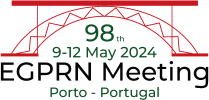Eurodata study: the role of primary health care during COVID-19 in Europe
Sara Ares Blanco, Marina Guisado Clavero, Ileana Gefaell, Lourdes Ramos Del Rio, Kathryn Hoffmann, Elena Brutskaya-Stempkovskaya, Marijana Jandrić-Kočić, Radost Assenova, Goranka Petricek, Miroslav Hanževački, Asja Ćosić Divjak, Heidrun Lingner, Theresa Sentker, Philippe-Richard J. Domeyer, Maria Bakola, Peter Torzsa, Ábel Perjés, Louise Fitzgerald, Limor Adler, Shlomo Vinker, Ferdinando Petrazzuoli, Alice Serafini, Murauskienė Liubovė, Martin Sattler, Maryher Delphin Peña, Aleksandar Kirkovski, Dragan Gjorgjievski, Katarzyna Nessler, Anna Krzton-Krolewiecka, Carmen Busneag, Snežana Knežević, Milena Kostić, Davorina Petek, Büsra Çimen Korkmaz, Erva Kirkoç, Оксана Ільков, Shushman Ivanna, Bruno Heleno, Ana Luísa Neves, Bert Vaes, Sherihane Bensemmane, Anna Segernäs, Naldy Parodi, Sven Streit, Senn Oliver, Raquel Gómez Bravo, María Pilar Astier Peña, Eurodata Collaborative Group
Keywords: COVID-19, primary health care, Europe, population surveillance, clinical pathways, health status indicators, apps, vaccination
Background:
Most COVID-19 cases received care exclusively through Primary Health Care (PHC). Although the role of PHC during the pandemic has been described in certain aspects, it has not been comprehensively covered for all areas where PHC operated in Europe.
Research questions:
What was the role and visibility of PHC during the pandemic in Europe?
Method:
Descriptive, cross-sectional, retrospective study involving 27-31 European countries. Qualitative data were gathered through a semi-structured questionnaire to assess PHC's role in COVID-19 pathways, Long Term Care Facility (LTCF), indicators, apps, vaccination, and immunization information systems. A Delphi study was conducted to define COVID-19 indicators for PHC. Data collection spanned March 2020-December 2021.
Results:
In 27 countries, PHC served as the entry point for COVID-19 patients, while Telehealth services were conducted in 30 countries. There was no consensus on the isolation duration, and General Practitioners (GPs) issued sick leaves in 21 countries. Diagnostic resources and treatments varied across regions. PHC provided COVID-19 care in 22 countries, with LTCF nurses coordinating care in 19 countries. Only 13 countries collected PHC activity indicators, and 5 shared the same indicator (total COVID-19 cases in PHC). A Delphi study identified the preferred indicator as COVID-19 cases in PHC/total respiratory infection cases. Five countries integrated the COVID-19 app with PHC information systems.
COVID-19 vaccines were administered in PHC in 25 countries, with nurses and GPs administering them in 25 and 21 countries, respectively. PHC actively participated in vaccine communication campaigns in 10 countries, showing heterogeneity in priority group criteria and vaccine types. Finally, 19 countries integrated Immunization Information Systems into PHC.
Conclusions:
PHC had a relevant role in COVID-19 pandemic but heterogeneity has been described in PHC managing COVID-19 pandemic across European countries. Specific indicators from PHC might be included in future pandemics.
Points for discussion:
How could the work of Primary Health Care be given more visibility during the pandemic?
How could inequities in access to complementary tests and treatments be reduced in Europe?
How could information systems in Europe be improved to make interoperability between medical records, epidemiological surveillance systems, and patient access to their medical records a reality?
#163

